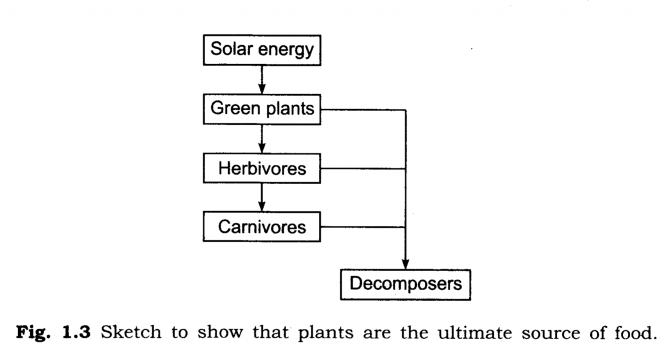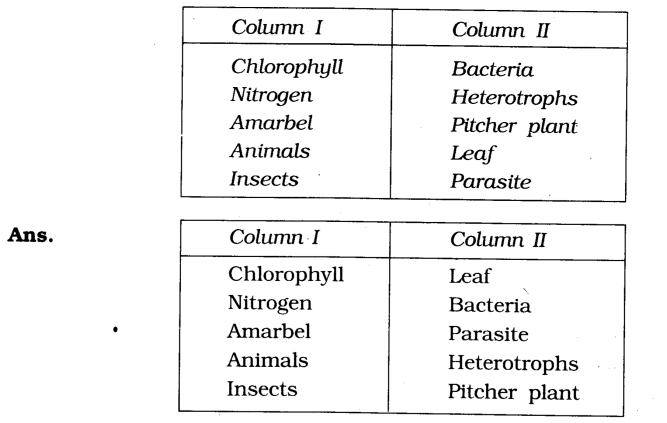NCERT Solutions for Class 7 Science Chapter 1 Nutrition in Plants
Q.1. Why do organisms need to take food?
Ans. Food is needed by all organisms for many purposes:
(a) The main function of food is to help in growth.
(b) Food provides energy for movements such as running, walking or raising our arm.
(c) Food is also needed for replacement and repairing damaged parts of body.
(d) Food gives us resistance to fight against diseases and protects us from infections

Q.3. How would you test the presence of starch in leaves?
Ans. The presence of starch in leaves can be tested by Iodine test. When we remove chlorophyll from leaf by boiling it in alcohol and then put 2 drops of iodine solution, its colour change to blue indicates the presence of starch.
Q.4. Give a brief description of the process of synthesis of food in green plants.
Ans. The green plants have chlorophyll in the leaves. The leaves use C02 and water to make food in presence of sunlight.
Q.5. Show with the help of a sketch that the plants are the ultimate source of food.
Q.6. Fill in the blanks:
(a) Green plants are called ________________ since they synthesise their own food.
(b) The food synthesised by the plants is stored as ________________ .
(c) In photosynthesis solar energy is captured by the pigment called ________________
(d) During photosynthesis plants take in ________________ and release ________________ .
Ans. (a) autotrophs (b) starch (c) chlorophyll (d) carbon dioxide, oxygen
Q.7. Name the following:
(i) A parasitic plant with yellow, slender and tubular stem.
(ii) A plant that has both autotrophic and heterotrophic mode of nutrition.
(iii) The pores through which leaves exchange gases.
Ans. (i) cuscuta (ii) Insectivorous plant (iii) Stomata
Q.8. Tick the correct answer:
(a) Amarbel is an example of:
(i) Autotroph (ii) Parasite (iii) Saprotroph (iv) Host
(b) The plant which traps and feeds on insects is:
(a) Cuscuta (ii) China rose {iii) Pitcher plant (iu) Rose
Ans. (a) (ii) Parasite (b) (iii) Pitcher plant
Q.9. Match the items given in Column I with those in Column II:
Q.10. Mark T’ if the statement is true and ‘F’ if it is false:
(i) Carbon dioxide is released during photosynthesis. (T/F)
(ii) Plants which synthesise their food themselves are called saprotrophs. (T/F)
(iii) The product of photosynthesis is not a protein. (T/F)
(iv) Solar energy is converted into chemical energy during photosynthesis. (T/F)
Ans. (a) F (ii) F (iii) T (iu) T
Q.11.Choose the correct option from the following.
Which part of the plant takes in carbon dioxide from the air for photosynthesis?
(i) Root hair (ii) Stomata (iii) Leaf veins (iv) Sepals
Ans. (ii) Stomata
Q.12. Choose the correct option from the following:
Plants take carbon dioxide from the atmosphere mainly through their:
(i) Roots (ii) Stem (iii) Flowers (iv) Leaves
Ans. (iv) Leaves